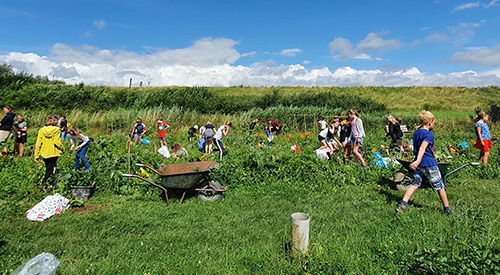

From Herman Vroklage
Allotment garden sites are green beacons of tranquillity and biodiversity in urban areas. Which more and more people are enjoying. They need to value and protect these unique places. Nevertheless, they are often under pressure due to housing development plans.
Ons Genot in Utrecht is one such allotment park whose future is uncertain. They discovered by chance that its survival is under discussion in the environmental vision of Utrecht Overvecht. Up to 8.6 hectares of garden space are at risk of disappearing due to the construction of sports fields in a new neighbourhood. The allotment gardeners of Ons Genot are fighting against this and are supported by the national interest group AVVN together with Natural Gardening.
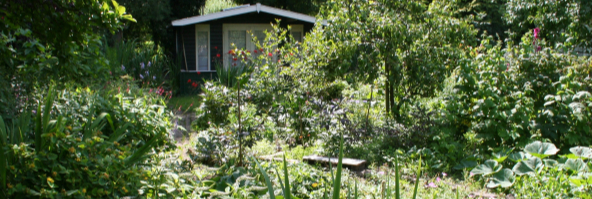
Urgent letter
AVVN has sent an urgent letter to the Mayor and Councillors calling for the allotment garden to be recognised and valued for its green qualities, its biodiversity and its recreational and social function, and for the allotment garden to be preserved in its current location.
That would be only right. The garden park has existed since 1963, the gardens and the surrounding greenery have reached full maturity and form an oasis for native and nature-friendly plants and animals. The allotment park makes a significant contribution to urban biodiversity, to reducing the heat island effect and to water infiltration and collection.
Community gardening is a social event. If Ons Genot disappears, many people will suffer: the 200 allotment gardeners and their families, volunteers from outside the association who work in the allotment garden and, of course, the many visitors such as the lunchtime walkers from the Nieuw Overvecht industrial estate.
Ons Genot and allotment gardens belong in the neighbourhood
AVVN advocates that the beautiful nature and recreational green spaces of Ons Genot become an integral part of the new neighbourhood to be built - with all the green and recreational functions they offer.
According to the AVVN, it is a mystery why a green gem like Ons Genot, with all its benefits for the municipality and a long-term lease agreement with the municipality, is suddenly under threat. Does the municipality still have a good idea of the added value of allotment gardens? AVVN invites the board to a new introduction to allotment gardening. A visit to Ons Genot fits in with this.

More information:
Visitors are welcome at Ons Genot! You will find them at 2e Polderweg 5 in Utrecht.
Opening hours: In summer from 8.00 am to 8.00 pm & in winter on Wednesdays and
Saturdays.
You can find more information on the Ons Genot website.
As a garden park, why open and cooperate with the surrounding area?
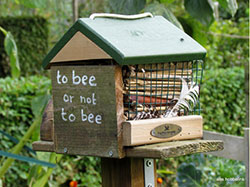 There are many reasons why you might want to involve the area around an allotment park in your garden association.
There are many reasons why you might want to involve the area around an allotment park in your garden association.
Possibly it is too much work to manage the allotment gardens properly and hands are needed. Perhaps there are people outside the garden gate waiting to be of service. Lending a hand with chores or working in the garden. Or gardeners may not feel seen and known for their useful work for nature, biodiversity and healthy food in the outside world, because the association is too closed.
Another reason could be a lurking threat to the survival of the allotments. This could be a termination of a contract with the municipality or owner, because of other plans like housing development.
But the purpose of opening up a garden park will always be to maintain yourself as a garden association in the long term. Even better: revalorising an allotment site and association into a more highly valued place and organisation in an urban area.
What to do when pressure and threats increase?
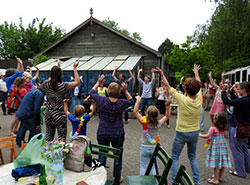 There is growing pressure on open space in the Netherlands. The government wants a lot of
new houses to be built in the Netherlands to be located within existing urban areas since the beginning of this century. Allotment gardens feel the pressure, unless their high social and environmental value.
There is growing pressure on open space in the Netherlands. The government wants a lot of
new houses to be built in the Netherlands to be located within existing urban areas since the beginning of this century. Allotment gardens feel the pressure, unless their high social and environmental value.
The allotment association of Ons Buiten in Utrecht experienced a serious threat at the beginning of this century. The beautiful park had to disappear, houses should take the place of the ornamental allotments, the small animal pasture, the vegetable gardens and of course also the gardeners. How could this association convince the city board of the importance for the urban environment? How could the board and the gardeners continue to garden in the place they had made so beautiful and natural together?
This were the main questions to find answers to.
They needed help. Fortunately, they were able to engage Wageningen University to conduct research.
How to become indispensable to the city and the municipality?
 The researchers realised a participatory study together with gardeners, people from the neighbourhood and representatives of institutions such as the neighbourhood council, schools and AVVN. The leading question was: how to make ourselves indispensable to the city and the municipality. This resulted in a manual that could lead to success in the next decade.
The researchers realised a participatory study together with gardeners, people from the neighbourhood and representatives of institutions such as the neighbourhood council, schools and AVVN. The leading question was: how to make ourselves indispensable to the city and the municipality. This resulted in a manual that could lead to success in the next decade.
This happened in 2006.
Some 10 years later in 2016, a successfully operating partnership has been realised between Gardenpark Ons Buiten and the environment.
Many allotment parks in the Netherlands have since benefited from this process and this way of working. Even municipalities nowadays embrace this set-up to benefit from garden parks in the pursuit of more greenery and biodiversity in urban areas. Of course, it is important to be able to further tell this story to our European friends of the Federation. At the end of this article, there are finding places on the internet for more info.
How do you realise added value in the face of threats?
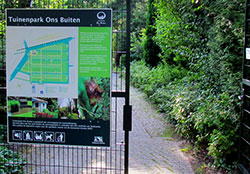 It is important to make a well-considered start.
It is important to make a well-considered start.
To start a change process, it is important to be well organised internally. Keep in mind that your association's vision or organisational structure may need to be changed, to properly handle the desired future. Consult other similar initiatives, learn from others. Be flexible.
Consider these points:
• Formulate a clear need (e.g. at garden park Ons Buiten: “to stay here in the city we need to reinvent ourselves, otherwise houses will come here”).
• Examine the current functioning with the entire association (e.g. at Ons Buiten garden park a meeting was organised for members to express all criticisms, ideas and wishes, and very important: to be included in the plans)
• Draw up a vision (e.g. We want to mean something to the whole society as an association)
• Inform everyone about plans and developments (e.g. make newsletters and welcoming information meetings)
• Structure the planned changes (make a plan of action, working groups, make the changes visible in an annual plan e.g.)
• Quickly take the first irreversible steps of achieved successes and quick wins (e.g. a new name: Tuinenpark Ons Buiten (= gardenpark), local residents were allowed to use a vegetable garden, the animal pasture was expanded).
• Create informal meeting moments (e.g. organise a treasure hunt for children, organise a dinner for all interested persons, members and people from the neighbourhood).
Searching for a new and appropriate direction and role for the allotment site involve exploring their meaning for the members and the people living and working in the neighbourhood.
If you want to cooperate with the environment, it is important to go through a number of steps to gain insight into changes you can make.
You can figure this out easily. Identify the qualities of your association and your garden park. Ask various people and institutions in your area what they think and want of your association and activities. Find out from the results what you have to do to meet the desired future image.
In the case of Garden Park Ons Buiten, the following conclusion was drawn in summary: Many qualities but too closed to the outside. Needed were an inviting attitude and attention to the outside, openness, democracy and cooperation inside. It became clear that the social and ecological values of Tuinenpark Ons Buiten were not always fully appreciated or utilised. As members they were often not as welcoming as they could be. They felt they could offer more to the adjacent neighbourhood! But how to organise this in successful way?
Social value in three layers: ecological, social and cultural.
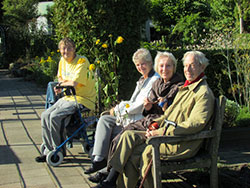 Garden Park Ons Buiten organised the approach to innovations as follows.
Garden Park Ons Buiten organised the approach to innovations as follows.
A garden park's significance to society has an ecological, a social and a cultural level:
Ecology (such as environment, food quality, biodiversity, soil) forms the basis. It is important not only for the location itself, but also for the natural value and liveability of the city. On this, the social level (such as friendship, cooperation, desire to belong) develops. On top of the social we find the cultural layer (such as landscape elements, garden styles, artistic elements and an eye for beauty).
They made working groups into which the inventoried measures to be taken fitted logically:
• working group green management
• working group on accessibility and buildings
• working group public and social activities
• working group communication
• working group for purchasing and management
Concrete measures were many, sometimes small, sometimes far-reaching. Such as putting up signposting, recreational shared use borders, sensory garden for the elderly, making inviting signs, placing benches and picnic tables, getting rid of hedges or pruning them low, welcoming volunteers for the animal pasture, opening the clubhouse to organisations from the area, organising activities for children, updating the clubhouse, offering services to the neighbourhood, renovating paths in the garden park, strengthening the ecology, ad information about interesting plants and trees, inviting neighbours to take place in committees or board, information about do’s and don’ts, resolving a conflict with a street, making a script for a film about this process on local TV, ensuring a dazzling presentation for the public and media.
Participants in working groups could sign up during meetings or were invited by fellow members. The delegates of the groups formed the steering committee. The chairman of the steering committee, also a board member, was the linking pin with the board and the proposed decisions in the General Assembly of Members. This set-up made it possible to continue the change process without disrupting normal board work. At the same time, it was possible to work on a change process internally in the association. Especially because a lot of members were active in the working groups.
After about 8 years, the work was completed and incorporated into the association's policy. Even after these years, the initiated process of change appeared to continue. To this purpose, the association uses the instrument of member consultation meetings. As soon as new policy proposals emerge, they are jointly discussed before decision-making takes place. This has led, for example, to an energy-neutral policy: green roofs, green lighting, solar panels, central water point, everything organic.
What should you pay attention to when creating added value?
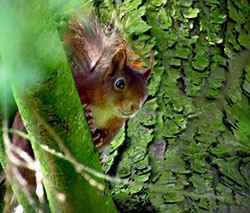 A change process as described here can only succeed if the efforts are rewarding for all participating parties. Several forms are possible of joint efforts with desired success. Some examples show how to deal with this.
A change process as described here can only succeed if the efforts are rewarding for all participating parties. Several forms are possible of joint efforts with desired success. Some examples show how to deal with this.
One of them is cooperation. During the process, Garden Park Ons Buiten started cooperation with two neighbouring garden parks, De Pioniers and Ecological Garden Park de Driehoek. They took measures for prevention and security together with the police and the municipality. This positively influenced the change process, as it strengthened trust for a good outcome.
A second way is to form a coalition. This means that two or more parties agree to work together to achieve a common desired outcome. It also means that together they are willing to compromise.
An example is the resolution of a conflict between the public strip on the north side of the park and the street located there. Both parties were mutually in discord on both sides of a small canal. The neighbours in the street were suffering from too much shade from tall trees and a messy appearance, while the gardeners were experiencing disturbances due to children of neighbours appearing in their gardens too often. The municipality was aware of overdue maintenance and came to the rescue financially. Garden Park Ons Buiten started a project led by a landscaper. After an inspection on both sides, both parties appeared to agree 80 per cent and everyone was able to put their shoulders to the project. The discord disappeared into a beautiful collaboration. Some neighbours became active in the association and even a neighbour joined the board. To this day, residents help the association keep this now beautiful natural strip tidy. They say they are lucky to live there with the view of a beautiful park.
An important way of mutual benefit manifests itself in a contract. As mentioned, the municipality was planning to build houses on this site. During the period of change, the end date of the association's collective rent contract with the municipality was approaching. Fortunately, the interim successes had reached the municipal council and the city council through successful PR, and the mood was in favour of retaining the garden park. In preparation for a new contract, the association, together with the other garden parks in the city and AVVN, pleaded for a longer contract than the then current 10 years. This succeeded with a contract of 2 x 10 years successively. In addition, the municipality, in cooperation with the allotments and the AVVN, provided a policy document that was officially adopted by the city council in 2012. A satisfying thought for the allotment holders that with the path taken, they were also able to secure contractual security.
Finally, the best part: celebrating the success achieved. It is now a tradition at Ons Buiten garden park: the annual Groenmoetjedoen day with activities such as wheelbarrow races, open gardens, live music. It is a warm welcome for members, local residents and others. It is an urban day, so all visitors are welcome. Most times, some officials and political representatives come for a drink and a chat. Sometimes the association invites the mayor to mark a special event. We mention: the opening of the new chicken house, the birth of a goat, the adoption of an animal from the animal pasture, events with a nod to background interests. Informally connecting with each other and light-hearted networking makes many flowers bloom.
Result: Gardenpark Ons Buiten became indispensable for the neighbourhood ...
• Ecological green management realized
• Created a meeting place and added value for the neighbourhood and allotment gardeners
• Anchored in networks and institutions
• Talents discovered, resources found and invested
• Improving the quality showed that more people are using and enjoying the park• And the neighbourhood became indispensable for Gardenpark Ons Buiten
Ans Hobbelink,
Member of the Management board of AVVN and allotment gardener in Utrecht
(Source: Hyphen 78)
Read more?
De meerwaarde van tuinparken, De betekenis van tuinparken in een stedelijke omgeving, Rapportnummer 222, ir. Noor van der Hoeven en dr. ir. Derk Jan Stobbelaar, Wageningen, mei 2006, https://edepot.wur.nl/44891
Tijd van de tuin, Ans Hobbelink, Hanneke van de Klippe, Hans Lägers, Utrecht, Tuinenpark Ons Buiten, december 2016,
http://www.onsbuitenutrecht.nl/syndeo_data/media/TijdVoorDeTuin.pdf
Een Nieuwe Koekelt: kloppend groen hart van Ede, J. Kruit, H. van Blitterswijk, J. Stokhof de Jong, J. Duyf, G. Rijnbeek, J. de Zwart, Rapportnummer 258, Wageningen Environmental Research 2009,
https://library.wur.nl/WebQuery/wurpubs/384770
Welkom op Tuinenpark De Koekelt, De kracht van tuinenparken voor de wijk, Lise Alix en Hansje Eppink, Rapportnummer 284, Wageningen, april 2011,
https://www.yumpu.com/nl/document/view/20116627/zo-tuinieren-zij-dus-wageningen-ur-e-depot
Bewoners maken het groen, Derk Jan Stobbelaar, Van Hall Larenstein University of Applied Sciences, Landwerk, February 2012 https://www.researchgate.net/publication/259867382_Bewoners_maken_het_groen
 School Garden Month: May 9-31. 2022
School Garden Month: May 9-31. 2022
"Every Child has a school garden." Sowing, tending and harvesting fruits and vegetables themselves.
With this mission, Alliantie School Tuinen (School Garden Alliance) was founded last year.
Alliantie School Tuinen works to ensure that every child has a school garden during their elementary school years.
Research shows that teachers think school gardens are important and they want to start! Unfortunately, only less than half have access to a school garden. In addition, teachers need support, knowledge and skills.
Get information about the campaign and support opportunities here.
https://alliantieschooltuinen.nl/
